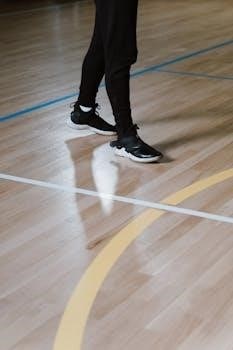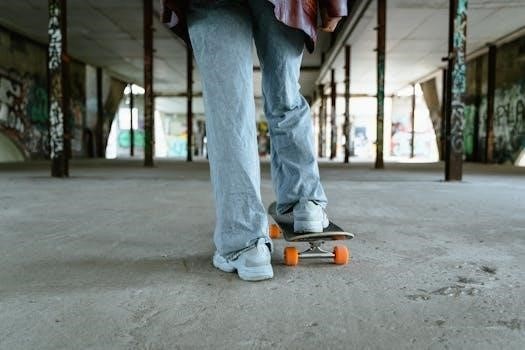Anterior Hip Replacement Exercises PDF⁚ A Comprehensive Guide
Embark on your journey to recovery with our comprehensive guide to anterior hip replacement exercises. This PDF provides valuable information, empowering you through each rehabilitation phase. Optimizing hip strength for a successful recovery!
Anterior hip replacement is a minimally invasive surgical procedure designed to alleviate hip pain and restore mobility. Unlike traditional approaches, the anterior approach accesses the hip joint from the front, potentially leading to a faster recovery and reduced risk of dislocation. Rehabilitation is a crucial component of the recovery process, focusing on regaining strength, flexibility, and function.
This comprehensive guide provides a structured exercise program to support your rehabilitation journey after anterior hip replacement. The exercises outlined are intended to strengthen the muscles surrounding your hip, improve joint motion, reduce swelling, decrease pain, and enhance balance and endurance. Remember to consult with your physical therapist or healthcare provider before starting any new exercise program. The key to successful rehabilitation is consistency and adherence to the prescribed exercises.
Early Post-Operative Exercises (Weeks 1-2)
The initial weeks following anterior hip replacement are focused on gentle exercises to promote circulation, reduce swelling, and initiate muscle activation. These exercises are typically performed while lying down to minimize stress on the hip joint. Remember to perform all exercises slowly and within your pain tolerance. The goal is to gradually increase your range of motion and strength without overexerting yourself.
During this period, weight-bearing will likely be limited, often involving the use of assistive devices. Focus on controlled movements and proper form. Listen to your body and avoid any activities that cause sharp pain. Consistency is key, aiming for frequent, short exercise sessions throughout the day. Your physical therapist will guide you on the appropriate progression and modifications based on your individual needs. Always prioritize safety and follow their specific instructions.
Ankle Pumps and Knee Rolling
Ankle pumps and knee rolling are crucial early exercises post-anterior hip replacement, designed to improve circulation and gently mobilize the lower extremities. For ankle pumps, lie on your back and alternately point your toes towards your head, then away, engaging your calf muscles. Repeat this motion rhythmically, promoting blood flow and preventing stiffness. Knee rolling involves lying supine with knees bent. Gently rotate your knees from side to side, keeping your feet planted. This exercise increases hip mobility and reduces muscle tension.
These simple yet effective exercises can be performed multiple times daily, as tolerated, within the first two weeks after surgery. Focus on controlled movements and avoid any sharp pain. Consistency is key to a smooth recovery, and these exercises lay the foundation for more advanced rehabilitation exercises. Listen to your body, and consult your physical therapist for guidance and modifications as needed to ensure proper form and prevent complications.
Intermediate Exercises (Weeks 2-6)
As you progress in your recovery from anterior hip replacement surgery, the intermediate phase (weeks 2-6) focuses on gradually increasing strength and range of motion. During this period, you’ll transition to exercises that challenge your hip muscles while remaining mindful of any discomfort.
Exercises during this stage might include gentle hip abduction exercises, which involve moving your leg away from your body while standing or lying down. Short arc quads can also be introduced to strengthen the thigh muscles. Partial squats, performed with caution and proper form, contribute to rebuilding leg strength. Remember to prioritize balance and stability during all exercises, using support as needed. Consult with your physical therapist to ensure proper technique and progression. It is very important to gradually increase intensity as tolerated to promote optimal healing and functional recovery.
Standing Hip Abduction
Standing hip abduction is a crucial exercise in the intermediate phase of recovery following anterior hip replacement, typically performed between weeks 2 and 6. This exercise targets the hip abductor muscles, which are essential for stability and balance during walking and other weight-bearing activities.
To perform this exercise, stand tall, holding onto a sturdy chair or countertop for support if needed. Slowly lift your surgical leg out to the side, keeping your knee straight and your body upright. Avoid leaning or rotating your torso. Hold the lifted position for a few seconds before slowly lowering your leg back to the starting position. Repeat this movement 10-15 times, or as directed by your physical therapist. Focus on controlled movements and proper form to maximize effectiveness and minimize risk of injury. Gradually increase repetitions as tolerated to improve hip strength.
Advanced Exercises (Weeks 6-12)
As you progress in your recovery from anterior hip replacement, typically around weeks 6 to 12, you can begin incorporating more challenging exercises to further strengthen your hip and improve functional mobility. These advanced exercises prepare you for a return to your desired activities and recreational pursuits.
This phase focuses on building strength, endurance, and balance. It’s crucial to listen to your body and gradually increase the intensity and duration of your workouts. Always consult with your physical therapist before starting any new exercise to ensure it’s appropriate for your individual needs and recovery progress. Advanced exercises might include squats, lunges, step-downs, and resisted hip abduction/external rotation exercises, along with light agility, balance, and cardiovascular activities. The goal is to enhance your overall fitness and confidence in performing daily tasks.
Squats, Lunges, and Step-Downs

In the advanced phase of rehabilitation following anterior hip replacement, squats, lunges, and step-downs are crucial exercises for regaining strength, balance, and functional mobility. These exercises mimic everyday movements, preparing you for a safe return to normal activities.
Squats help strengthen the quadriceps, glutes, and hamstrings, while lunges improve balance and stability. Step-downs target the quadriceps and help control movement during activities like walking downstairs. Begin with shallow squats and lunges, gradually increasing the depth as your strength improves. Use a support, like a chair or wall, for balance if needed. Ensure proper form to avoid placing excessive stress on your hip joint. Perform these exercises under the guidance of your physical therapist, who can tailor the program to your specific needs and monitor your progress. Remember to listen to your body and stop if you experience any pain.
Precautions After Anterior Hip Replacement

Following anterior hip replacement, adhering to specific precautions is crucial for protecting your new hip joint and ensuring optimal healing. These precautions aim to prevent dislocation and minimize stress on the surgical area during the initial recovery period.

Typically, anterior hip replacement involves fewer restrictions compared to other approaches. However, certain movements should be avoided to ensure stability. It’s essential to avoid excessive hip extension, where the leg moves too far behind the body, and external rotation, where the leg turns outward excessively. Your physical therapist will provide personalized guidance on specific movements to avoid based on your individual case. Always consult with your healthcare team before engaging in any new activities or exercises. Adhering to these precautions will contribute significantly to a successful recovery and long-term hip health.
Avoiding Hyperextension and External Rotation
After an anterior hip replacement, carefully avoiding hyperextension and external rotation is vital for preventing complications. Hyperextension, moving your leg excessively backward beyond a neutral position, can strain the anterior hip capsule. Similarly, external rotation, turning your leg outward from your hip joint, can also compromise stability.
During daily activities, be mindful of your hip’s position. Avoid reaching far behind you or twisting your leg outward while sitting or standing. When lying down, keep a pillow between your knees to prevent external rotation. Your physical therapist will demonstrate safe movement techniques and provide personalized strategies. By diligently avoiding these movements, you can minimize the risk of dislocation and promote a smooth, successful recovery following your anterior hip replacement. Remember, consistent awareness is key to protecting your new hip joint.
Importance of Physical Therapy
Physical therapy is an indispensable element in the rehabilitation process following anterior hip replacement. A qualified physical therapist provides personalized guidance and support, ensuring a safe and effective recovery. They design exercise programs to strengthen the muscles surrounding your hip, improve joint mobility, reduce swelling, and alleviate pain.
Through structured sessions, you’ll learn proper movement techniques, balance exercises, and strategies for managing daily activities. Physical therapists monitor your progress, adjusting the program to meet your evolving needs and address any challenges. Their expertise helps you regain optimal function, prevent complications, and return to your desired activities with confidence. Engaging actively in physical therapy empowers you to take control of your recovery, maximizing the long-term benefits of your hip replacement and enhancing your overall quality of life. Remember consistency is key to success.
Functional Training and Return to Activity
Functional training is a pivotal stage in your recovery journey, bridging the gap between structured exercises and real-world activities after anterior hip replacement. This phase focuses on exercises that mimic everyday movements like walking, stair climbing, and getting in and out of chairs. These exercises improve coordination, balance, and strength, preparing you to confidently resume your daily routines.

Working closely with your physical therapist, you’ll gradually reintroduce activities you enjoy, such as gardening, golfing, or dancing. They’ll assess your movement patterns, providing guidance on proper techniques to minimize stress on your new hip. Functional training ensures a smooth transition back to an active lifestyle. This phase builds confidence and independence by addressing the specific physical demands of your individual goals. Remember to listen to your body and progress at a comfortable pace as you regain your independence and enjoy your favorite pastimes.
Long-Term Hip Health and Exercise Maintenance
Maintaining long-term hip health following anterior hip replacement is crucial for enjoying a fulfilling and active life. Establishing a consistent exercise routine is key to supporting the stability and function of your new hip joint. Regular, low-impact activities like walking, swimming, and cycling help maintain muscle strength, flexibility, and cardiovascular health. Incorporate exercises that target hip abductors, extensors, and rotators to ensure balanced muscle development and prevent imbalances.
Listen to your body and avoid activities that cause pain or discomfort. Consult with your physical therapist or healthcare provider for personalized exercise recommendations and guidance. They can help you modify exercises to suit your individual needs and limitations. Maintaining a healthy weight, practicing good posture, and using proper body mechanics during daily activities are also essential for protecting your hip joint. Prioritizing long-term hip health through consistent exercise and lifestyle modifications will contribute to sustained mobility, independence, and overall well-being.


